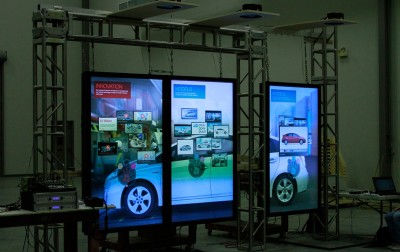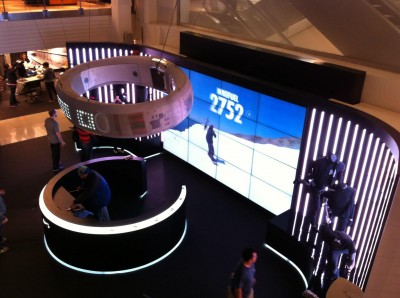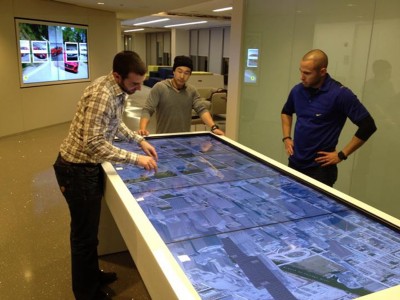Digital Signage: Considerations for interactive video walls
by all | 22 November 2013 8:30 am
 [1]
[1]Photos courtesy Horizon Display
By Jessica Webster
It has been a big year for interactive video walls, as more and more customers are adding them to their premises. Yet, to many professionals in the sign industry, interactive video walls still remain something of a mystery. To gain a better grasp of this larger-than-life medium, it is important to understand the various components needed to build the entire system, including touch-sensitive technologies, glass or plastic covers and installation and mounting equipment, to name a few.
Interactive or passive?
The first decision is whether or not the video wall should be touch-enabled at all, rather than ‘passive,’ for passersby. Converting an audience from spectators to participants can certainly improve the effectiveness of the media experience, but in some cases, it is not necessary to do so. The choice will depend on objectives and budgets—with passive video walls being the less expensive option.
Even if the goal is to create a ‘wow’ moment for the audience, interactivity may not be necessary. Some of today’s largest, most impressive and memorable video walls are eye-catching enough to command attention without facilitating direct interaction by touch.
That said, when a liquid crystal display (LCD) is placed within reach of passersby today in a public environment, they will usually try touching it. People today are coming to expect touch-based interactivity to be part of most of the screens they encounter, enabling a more personalized, dynamic and entertaining experience.
 [2]
[2]A lot of planning is required to create an effective interactive video wall.
Touch technologies
Even when it is clear a touch-screen experience will best suit a project’s objectives, there are further decisions to be made, as that experience can be delivered in many ways. There are at least eight different touch technologies, some of which encompass multiple subcategories. Choosing the right one may seem daunting for a sign company that is new to the technology.
Fortunately, help is available to those who seek it. Some audiovisual (AV) integrators, for example, can train signmakers with the technology, so they in turn can communicate effectively to their customers.
Touch points themselves are a major consideration. If the on-screen content requires only mouse-like control by fingertip, then a simple single- or dual-touch configuration will suffice. On the other hand, if the content requires multi-touch gestures, like pinches, swipes and newer custom movements, then a minimum of six touch points would be recommended for a user’s hand. And if an interactive video wall will be used by several passersby simultaneously, then it may need 12 or 32 touch points to accommodate the intended experience.
One of the most well-rounded options in this respect is an infrared-based (IR-based) touch screen that can handle anywhere from two to 32 simultaneous touch points, for single or multiple users. It is more accurate than some other options and resistant to interference from higher levels of ambient light.
It is also worthwhile to take future-proofing into account. As the client’s business strategies change, technology will change even quicker. To make the initial investment yield continual success for the customer, the sign shop will need to try to anticipate future trends and developments. For the client who only needs one or two touch points today, a single-touch video wall may well seem ancient tomorrow, as people expect to be able to flick, pinch and swipe on-screen content.
Glass options
In video wall applications, the ‘substrate’ is the glass (tempered or plate), polycarbonate resin thermoplastic or acrylic material integrated in front of the screen itself.
Typically, large sheets of tempered glass are optically imperfect, so up-close viewing—i.e. within 0.6 m (2 ft)—can be negatively affected by glass contaminants. They can appear wavy from the tempering process.
Plastic-derivative sheets may be a better option for such deployments, but some of these sheets are too thin. The heat from the video wall’s LCDs can cause them to ‘bow out’ into the IR plane of the touch ‘frame,’ resulting in false touch detections and, thus, a completely useless deployment.
It is important to consider a substrate’s overall durability for shipping, handling and installation in high-traffic areas. Installing large sheets of non-tempered plate glass in tight spaces requires very steady hands to avoid cracking or breaking them. Plastic sheets are much lighter and safer to handle.
The downfall of plastic substrates, however, is their lack of durability against scratches. While a polycarbonate resin thermoplastic is virtually unbreakable due to its flexibility, it can easily be scratched by a user wearing a ring or holding a key. Acrylic is harder and somewhat more resistant, but still easier to scratch than glass.
So, the choice of substrate is a balancing act between these factors. Some companies are comfortable handling glass, which typically is chemically strengthened for interactive displays. And some clients are not too worried about small scratches.
 [3]
[3]If an existing wall is being used to display a screen array, then it may be necessary to engineer additional structural supports.
Mounting LCD panels
Ultra-narrow-bezel LCDs are becoming popular for video walls because they leave a nearly seamless mullion between screens, but their design is also their Achilles heel, as the internal polarizer micro-wiring and glass are extremely fragile. They are protected by only about 2 mm (0.08 in.) of flexible tin.
As a consequence, an ultra-narrow-bezel LCD cannot bear the weight from another one above it. Any weight applied to the bezel can damage the polarizer, break the internal glass or cause entire columns of the screen to fail.
Similarly, everyday LCD mounts may not be sufficient, considering video walls are very heavy. If the construction is new, the appropriate mounting hardware and weights can be attained and integrated early in the process, with mounting points and surfaces designed accordingly to support the video wall.
If an existing construction is being used, then the structure may have trouble bearing the added weight. Options include support ‘legs’ that can be integrated into the wall-mounting system or using the floor to support the weight vertically. Either way, proper engineering is crucial to ensuring safety.
Serviceability is often overlooked in digital signage deployments. There are mounts specifically designed for video walls that ‘pop out,’ in one fashion or another, for maintenance. These are helpful with multi-row arrays of LCDs, where the central screens can be particularly difficult to access otherwise.
It is also important to consider cable management, ensuring the wiring scheme makes key components accessible for repair. Signal extension cables—e.g. Category 5 (Cat 5) twisted-pair cables, High-Definition Multimedia Interface (HDMI) cables and Universal Serial Bus (USB) extenders—are often the root cause of a video wall failure, so it is important to place them in an accessible location.
User experience
All of the hardware components will be little use, of course, if there is not already a clear definition of how software will be used to operate the video wall. This calls for careful planning of the content and experience strategy.
 [4]
[4]For certain user experiences, a touch-sensitive table may be more practical than a video wall.
In some touch-enabled video wall experiences, every possible interaction appears on-screen when a passerby first approaches the structure. This can be information overload, which will either make people confused what action they should take or lead them to assume the system is too complex for them to understand. It is important not to ask too much from them, tell them what to do or scare them away with too much information right off the bat.
The navigation experience should instead subtly lead users toward the client’s desired end point. This is called ‘conversion,’ a tenet already well-established throughout the online user interface (UI) development community.
The content will need to illustrate a value proposition, creating a call to action with a defined reward for the user. Then, as the user zooms in, the layers of content change before his/her eyes, offering new paths depending on which way he/she swipes the screen and clearly explaining what is next.
These types of immersive applications generally require no less than six months of planning, content development and user experience (UX) design. It is also important to use interactive software that can report on and analyze user interactions, so information can be gleaned from the actual real-world use of the video wall application.
Jessica Webster is art director for Horizon Display, which provides multi-touch monitors, kiosks, table displays and video walls. She works with clients and the company’s interactive strategy team to design graphical representation of content concepts. For more information, visit www.horizondisplay.com[5].
- [Image]: http://www.signmedia.ca/wp-content/uploads/2014/01/Sign3_test.jpg
- [Image]: http://www.signmedia.ca/wp-content/uploads/2014/01/Sign6.jpg
- [Image]: http://www.signmedia.ca/wp-content/uploads/2014/01/niketown6.jpg
- [Image]: http://www.signmedia.ca/wp-content/uploads/2014/01/Sign8.jpg
- www.horizondisplay.com: http://www.horizondisplay.com
Source URL: https://www.signmedia.ca/considerations-for-interactive-video-walls-3/